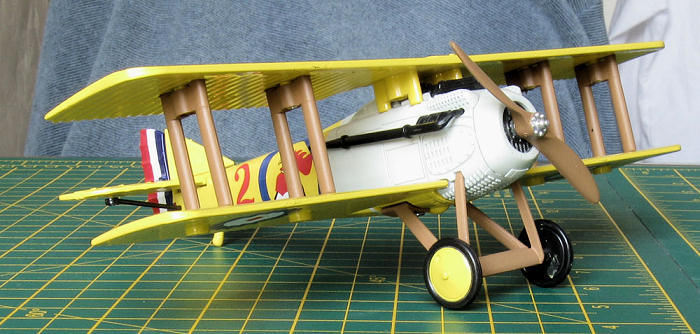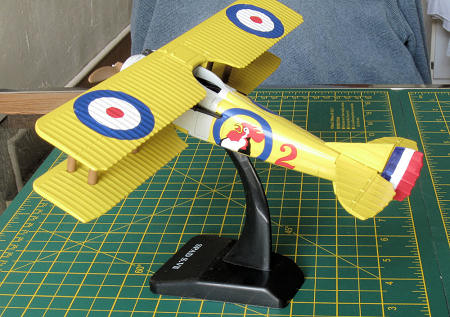
| KIT #: | 1370401 |
| PRICE: | £ 5.00 |
| DECALS: | Pre-painted |
| REVIEWER: | Jeff Simpson |
| NOTES: | The box says “not for children under 3 years” which raises the question of what age range is it suitable for? |

| HISTORY |
 The SPAD S.VII was the first of a series of highly
successful biplane fighter aircraft produced by Société Pour L'Aviation et
ses Dérivés (SPAD) during the First World War. Like its successors, the
S.VII was renowned as a sturdy and rugged aircraft with good
climbing
and diving characteristics. It was also a stable gun platform, although pilots
used to the more manoeuvrable Nieuport fighters found it heavy on the controls.
It was flown by a number of the famous aces, such as France's Georges Guynemer
and Italy's Francesco Baracca.
The SPAD S.VII was the first of a series of highly
successful biplane fighter aircraft produced by Société Pour L'Aviation et
ses Dérivés (SPAD) during the First World War. Like its successors, the
S.VII was renowned as a sturdy and rugged aircraft with good
climbing
and diving characteristics. It was also a stable gun platform, although pilots
used to the more manoeuvrable Nieuport fighters found it heavy on the controls.
It was flown by a number of the famous aces, such as France's Georges Guynemer
and Italy's Francesco Baracca.
| THE KIT |
The kit is
attractively presented in a box with a clear window showing the colourful
pre-painted parts. I assume the same box is used for all four planes in
New-Ray’s “Classic Planes” series: Fokker D
The main parts
are held in a clear plastic tray with the fuselage halves tied together with a
plastic band, a small sealed bag of screws and metal pins, a screwdriver and
another bag of struts and undercarriage. A very small slip of paper, with the
assembly instructions for all four of the kits in the series completes the kit.
I measured the span 225mm and length 176mm, both work out to be about 1/35 scale.
| CONSTRUCTION |
Although it
looks pretty in the box, I doubt this is an accurate model, I tried to build it
with a minimum of modelling and no painting.
The tiny
instructions are reasonably clear about what part goes where, but they do
require a bit of thought to determine which way round some of the parts should
be fitted. I guessed that the cowling front should be fitted with a square vent
at the bottom, the tail is held on by a washer screwed into the fin, that fits
into slots inside the fuselage, the rudder is trapped in a hinge at the
 end of
the fuselage. The fuselage has three metal locating pins that have to be trapped
in position while simultaneously trapping the cowling, cockpit tub, tail and
rudder – whew! It sort of works, but leaves a rather ugly gap along the top of
the fuselage. The pins are a tight fit, to hold the parts together, but if they
are too tight the modeller cannot force the parts home. A cautious trial fit of
the fuselage, maybe drilling out the locating holes, and trimming the rudder
hinge would probably enable a better fit to be achieved. The cowling and the
tail do hold the fuselage together, so the three pins are probably a bit of
overkill.
end of
the fuselage. The fuselage has three metal locating pins that have to be trapped
in position while simultaneously trapping the cowling, cockpit tub, tail and
rudder – whew! It sort of works, but leaves a rather ugly gap along the top of
the fuselage. The pins are a tight fit, to hold the parts together, but if they
are too tight the modeller cannot force the parts home. A cautious trial fit of
the fuselage, maybe drilling out the locating holes, and trimming the rudder
hinge would probably enable a better fit to be achieved. The cowling and the
tail do hold the fuselage together, so the three pins are probably a bit of
overkill.
The wing struts
are hopelessly inaccurate: looking like telegraph poles, they are screwed into
the top wing, being sure to have the hollow strut at the rear: something not
made clear in the instructions. The top wing is a tight push fit onto the
fuselage, the lower wing is held on by screws into the struts. At this point I
found I had to get a small (1.3mm) drill and ream out the hollow struts so that
the screws would go in.
The undercarriage is clipped on at the front and held to the fuselage by a screw. The stand is clipped together and Voila! A finished “model”. Total time, including finding my drills, less than half an hour.
| COLORS & MARKINGS |
 The roundels
with red centres and blue outer rings look British to me, although the
“Cockerel” marking on the fuselage side looks too flamboyant to be British? The
overall yellow colour also seems implausible.
The roundels
with red centres and blue outer rings look British to me, although the
“Cockerel” marking on the fuselage side looks too flamboyant to be British? The
overall yellow colour also seems implausible.
| CONCLUSIONS |
The pole struts spoil this model, however I cannot see anyone spending a lot of time “enhancing” it to try and make an accurate 1/35 scale model of a SPAD. As for the target market: the tricky fuselage juggling act and the poor fit of the lower wing screws would be frustrating for small children. It might be suitable for a joint building project with an adult (armed with scissors and drills) and an enthusiastic child? The finished model is robust enough to survive hours of playtime.
| REFERENCES |
http://en.wikipedia.org/wiki/Spad_VII
Jeff Simpson October
2009 Copyright Modeling Madness.com. All rights reserved. No reproduction in any form without express permission from the editor. If you would like your product reviewed fairly and quickly, please
contact
the editor or see other details in the
Note to
Contributors.